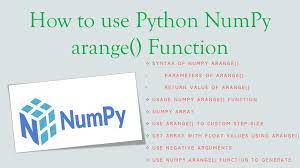What does Numpy Arange do | np.arange | Niche Blink

NumPy’s numpy arange() function is a valuable tool in Python for generating arrays of evenly spaced values within a specified range. It allows users to define the start, stop, and step sizes, making it ideal for creating sequences of numbers for various numerical operations. This function is widely used in scientific computing, data analysis, and mathematical tasks, providing a flexible and efficient way to generate arrays with specified increments or spacings.
What does Numpy Arange do?

NumPy’s np.arange() function is used to create an array of evenly spaced values within a specified range. It generates a 1-dimensional array containing numbers that start at a specified value, increment by a specified step size, and stop just before a specified end value. The syntax np.arange() is as follows:
numpy.arange([start], stop[, step, dtype=None])
start(optional): The starting value of the sequence. If not provided, it defaults to 0.stop: The end value of the sequence. The generated array will not include this value.step(optional): The step size between values. It represents the difference between each consecutive value in the array. If not provided, it defaults to 1.dtype(optional): The data type of the output array. If not provided, it is determined automatically based on the input values.
Here are some examples of how to use np.arange():
import numpy as np
# Generate an array of values from 0 to 4 (exclusive) with a default step of 1.
arr1 = np.arange(4)
# Output: array([0, 1, 2, 3])# Generate an array of even numbers from 2 to 10 (exclusive).
arr2 = np.arange(2, 10, 2)
# Output: array([2, 4, 6, 8])# Generate an array of values from 0 to 10 (exclusive) with a step of 0.5.
arr3 = np.arange(0, 10, 0.5)
# Output: array([0. , 0.5, 1. , 1.5, 2. , 2.5, 3. , 3.5, 4. , 4.5, 5. , 5.5, 6. , 6.5, 7. , 7.5, 8. , 8.5, 9. , 9.5])
np.arange() is particularly useful when you need to generate a sequence of numbers for various mathematical and data manipulation operations. It is commonly used in scientific and numerical computing with NumPy.
Numpy Arange vs Range:

NumPy’s numpy.arange() and Python’s built-in range() function serve similar purposes in that they both generate sequences of numbers. However, there are some key differences between the two:
- Data Type:
numpy.arange(): This function returns a NumPy array, which can contain elements of various data types, including floating-point numbers. The data type of the array is determined based on the input arguments.range(): Therange()function in Python (Python 2.x) returns a sequence of integers. In Python 3.x,range()returns a “range” object, which is not a list of numbers but a generator that can be iterated over. You can convert it to a list if you need to work with a list of numbers.
- Inclusiveness of End Value:
numpy.arange(): The end value is not included in the generated sequence. The sequence stops just before the end value.range(): The end value is not included in the generated sequence (in both Python 2.x and 3.x).
Here are some examples to illustrate the differences:
Using numpy.arange():
import numpy as np
# This will create an array with values from 0 to 4 (exclusive).
arr = np.arange(4)
# Output: array([0, 1, 2, 3])
Using range() (Python 3.x):
# In Python 3.x, you can convert the range object to a list for a similar result.
range_obj = range(4)
lst = list(range_obj)
# Output: [0, 1, 2, 3]
In summary, if you need a sequence of numbers with various data types, including floating-point numbers, and you’re working with NumPy, numpy.arange() is a more suitable choice. If you’re working with Python and only need a sequence of integers, range() can be used. In Python 3.x, you can convert a range object to a list to obtain a list of integers.
Numpy Arange vs Linspace:
NumPy’s numpy.arange() and numpy.linspace() functions are both used to create arrays of evenly spaced values, but they have some differences in how they generate those values:
numpy.arange():
- The
numpy.arange()function generates an array of evenly spaced values within a specified range by providing a start value, an end value, and an optional step size. - The end value is not included in the generated sequence, meaning the sequence stops just before the end value.
- You have control over the step size, which allows for more flexibility in specifying the spacing between values.
Example:
import numpy as np
arr = np.arange(start, stop, step)
numpy.linspace():
- The
numpy.linspace()function generates an array of evenly spaced values within a specified range by providing a start value, an end value, and the number of elements you want in the array. - Unlike
numpy.arange(), the end value is included in the generated sequence, and you specify the number of elements you want, so the step size is automatically determined based on the range and the number of elements.
Example:
import numpy as np
arr = np.linspace(start, stop, num)
Here’s a comparison between the two functions numpy arrange vs linspace:
numpy.arange()gives you control over the step size and generates values within a range. It is useful when you want to specify the spacing between values explicitly.numpy.linspace()allows you to specify the number of elements in the sequence and ensures that the start and end values are included. It’s useful when you need a fixed number of evenly spaced values over a specified range, and you don’t need to worry about setting the step size explicitly.
Consider the specific requirements of your task when choosing between numpy.arange() and numpy.linspace().
Numpy Arange 2d:
To create a 2D array using numpy.arange(), you can first create a 1D array using numpy.arange(), and then reshape it into a 2D array using the .reshape() method. The key is to make sure that the total number of elements in the 1D array matches the product of the dimensions you want for the 2D array (i.e., rows and columns).
Here’s how you can create a 2D array using numpy.arange():
import numpy as np
# Create a 1D array with values from 0 to 11 (exclusive).
arr_1d = np.arange(12)# Reshape the 1D array into a 2D array with 3 rows and 4 columns.
arr_2d = arr_1d.reshape(3, 4)# You can also achieve the same result in a single line.
arr_2d = np.arange(12).reshape(3, 4)print(arr_2d)
In this example, we create a 1D array with values from 0 to 11 using np.arange(12), and then we reshape it into a 2D array with 3 rows and 4 columns using .reshape(3, 4).
The output will be a 2D array like this:
array([[ 0, 1, 2, 3],
[ 4, 5, 6, 7],
[ 8, 9, 10, 11]])
You can adjust the dimensions (number of rows and columns) as needed to create 2D arrays of different shapes using numpy.arange().

Conclusion:
In conclusion, thenumpy arange() function in NumPy is a versatile tool for creating arrays of evenly spaced values within a specified range. It allows you to generate a sequence of numbers with various options:
- Start Value: You can specify a starting value for the sequence (optional). If not provided, it defaults to 0.
- Stop Value: You define the end value of the sequence, and the generated array will not include this value. This is a required parameter.
- Step Size: You can specify the step size between values (optional). If not provided, it defaults to 1.
- Data Type: The function can take an optional parameter for specifying the data type of the output array. If not provided, it is determined automatically based on the input values.
numpy.arange()is widely used in scientific computing, data analysis, and numerical operations. It is particularly useful when you need to create arrays for various mathematical and data manipulation tasks.




